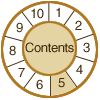

5. Metadata
Key
Concepts
METADATA
CREATION
Metadata creation and implementation are resource-intensive
processes. Balance costs and benefits in developing a metadata strategy,
taking into consideration the needs of current and future users and collection
managers. Identify metadata requirements at the onset of an imaging initiative.
These requirements should be tightly linked to functions that must be
supported (e.g., rights management, resource discovery, and long-term
care).
Consider
the following issues:
- Although some metadata elements are static (e.g., date of creation, scanning resolution), certain fields (e.g., migration information) may continue to evolve and require continuous updating and maintenance.
- The creation and management of metadata is accomplished through manual (creating a Dublin Core record) and automated (generating a keyword index from OCR'ed text) techniques. Similarly, metadata quality control will be based on a mix of manual (evaluating the quality of subject access categories and keywords) and automated (using an SGML parser to validate tags) processes.
- Metadata can be internal (file naming, directory structuring, file headers, OCR, SGML) or external (external indexes and databases). The key factor in decision making is evaluating whether the location supports functionality and resource management. For example, TIFF file headers are instrumental in recording metadata internally; however, this metadata is usually lost when the TIFF files are converted to other file formats, such as JPEG or GIF.
There are several standards in development to facilitate interoperability among different metadata schemes. The Resource Description Framework (RDF) is an XML-based application to provide a flexible architecture for managing diverse metadata in the networked environment. The goal of the Digital Imaging Group's Metadata For Digital Images (DIG 35) initiative is to define a standard set of metadata that will improve interoperability between devices, services, and software, thus making it easier to process, organize, print, and exchange digital images. The MPEG-7 (Moving Picture Experts Group) initiative targets audio-visual content description and aims to standardize a set of description schemes and descriptors, a language to specify description schemes, and a scheme for coding the description. The Interoperability of Data in E-Commerce Systems (<indecs>) project is an international collaboration to develop a metadata framework that supports network commerce of intellectual property.
| Example
What kinds of metadata will be created for a journal collection that is converted as 600 dpi, 1-bit TIFF 6.0 images? The following metadata tasks might be undertaken. Each is identified by its principle metadata type (S = structural, D=descriptive, A=administrative). Note: The RLG Model RFP provides an example of metadata requirements for a text imaging project.
|
|
Example
2 In addition to many of the elements suggested above, consider whether to·
|
© 2000-2003 Cornell University Library/Research Department